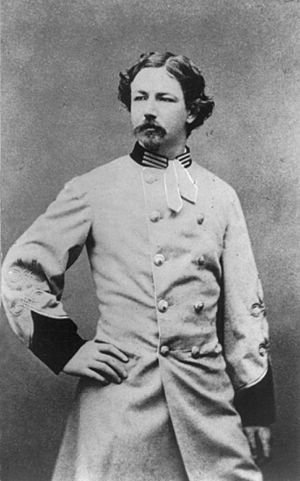William McNeill Whistler facts for kids
Quick facts for kids
William McNeill Whistler
MRCS, MRCP
|
|
|---|---|

Dr. William McNeill Whistler, C.S.A.
|
|
| Born | July 22, 1836 |
| Died | February 27, 1900 (aged 63) |
| Education | Columbia College Trinity College University of Pennsylvania School of Medicine |
| Relatives | George Washington Whistler (father) Anna McNeill Whistler (mother) |
| Medical career | |
| Profession | surgeon and medical doctor |
| Institutions | London Throat Hospital St George's Hospital. |
| Sub-specialties | Laryngological, Rhinological and Otological medicine |
William McNeill Whistler (born July 22, 1836 – died February 27, 1900) was an American doctor. He served as a medical officer for the Confederate Army during the American Civil War. He was also the younger brother of the famous artist James McNeill Whistler.
Contents
Growing Up: William Whistler's Early Life
Whistler was born in Lowell, Massachusetts. He was the second son of George Washington Whistler and Anna McNeill Whistler. His father was a former officer who became a civil engineer. He specialized in building railroads.
Moving to Russia
In 1842, Czar Nicholas I of Russia hired his father. George Whistler was to build the Saint Petersburg–Moscow Railway. The family moved to Saint Petersburg in Russia the next year. They lived in Russia for five years. In 1848, they left to escape a serious sickness called cholera. Sadly, George Whistler died from cholera the following year.
Education and Medical Training
After his father's death, Anna Whistler returned to the United States. She settled in Pomfret, Connecticut with her two sons. William went to Christ Church School in Pomfret. He also attended St. James College in Williamsport, Maryland from 1850 to 1852.
In 1853, he started at Columbia College. He did not finish his degree there. He was part of a student group called the Fraternity of Delta Psi. In 1855, he began studying to become a doctor at Trinity College in Hartford, Connecticut. He learned from Dr. James Darrach in Philadelphia starting in 1857. William then enrolled in the Pennsylvania Medical School in 1858. He graduated with high honors in 1860.
William Whistler's Medical Career
In 1860, Whistler moved to Richmond, Virginia. He wanted to become a medical officer in the Confederate States Army. When he could not get that job, he joined as a clerk in 1861. He needed money at the time. He wrote that as a doctor, he felt his true place was with the medical team. He knew he was not trained for other military roles.
Serving in the Civil War
In late 1862, he became an assistant surgeon. He worked in the Richmond area. This included helping at places like Libby Prison and Drewry's Bluff.
In April 1864, Whistler was sent to work in the field. He became an assistant surgeon for the 1st South Carolina Rifle Regiment. This group was also known as "Orr's Rifles." He arrived just in time for the battle of Spotsylvania Court House. He impressed his fellow soldiers. He stayed with the fighting troops to help the wounded. He also took part in other battles. These included Jericho Ford, Riddle's Shop, Petersburg, Deep Bottom, Fussell's Mill, Ream's Station, and Jones's Farm.
Journey to London
In February 1865, Whistler took four months of leave because he was not well. He decided to visit his mother in London. He was also given important government messages to deliver in Britain. He tried to sail from Charleston, South Carolina and Wilmington, North Carolina. However, Union troops blocked his way.
He then teamed up with another Confederate officer. They secretly crossed the Chesapeake and went through Union lines to Philadelphia. They used false names and wore regular clothes. He traveled to New York and sailed to London on the ship SS City of Manchester. He arrived in England and delivered the messages. A week later, he learned that Robert E. Lee had surrendered. This meant the war was over.
Life and Work in Europe
Whistler never went back to the United States. He spent a year traveling in Europe. He visited his brother, George William Whistler, in Russia. Then, he continued his medical career in Paris, France. He worked in hospitals and taught in medical schools there.
Around 1868, he moved to London. He opened his own medical practice. He also worked at St George's Hospital. He helped start the London Throat Hospital and became a senior doctor there. He became a member of important medical groups. These included the Member of the Royal College of Surgeons in 1871 and the Member of the Royal College of Physicians in 1876. He was also the president of the British Laryngological, Rhinological and Otological Association. This group focused on diseases of the throat, nose, and ear.
William Whistler's Family Life
In late 1860, William Whistler married his cousin, Florida "Ida" Bayard King. She was from Georgia. His wife encouraged him to support the Confederacy during the Civil War. They lived in Richmond, Virginia. Ida became sick and died in March 1863. His mother-in-law cared for her. William and Ida did not have any children.
On April 17, 1877, William married for a second time. His new wife was Helen "Nellie" Euphrosyne Ionides (1849-1917). She came from a rich Greek merchant family. She sometimes modeled for his brother, James Whistler. William and Helen also did not have any children.
His brother, James McNeill Whistler, painted William's picture several times. These paintings include Portrait of Dr. William McNeill Whistler and Portrait of Dr. Whistler, No. 2.
William McNeill Whistler died from influenza in 1900 at his home in London, England. He is buried at Hastings Cemetery and Crematorium in Hastings, East Sussex, England.
Images for kids
External resources
- Portrait by James McNeill Whistler


